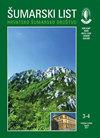在土耳其Artvin的雌性高发臭液体植物中显示的云纹松毛虫(Kugelann,1794)
IF 0.4
4区 农林科学
Q4 FORESTRY
引用次数: 0
摘要
1966年在土耳其首次发现的云纹松毛虫(Kugelann,1794),直到21世纪末,几乎在东黑海地区的所有东方云杉林中都有分布。在其不断扩大的战线上,它负责杀死代表数百万立方米木材的云杉树。近年来,东方云杉林中有这种害虫的地方性种群。但导致极端天气情况的极端气候条件可能会引发有利于米卡病爆发的合适环境。在这项研究中,我们旨在检验森林中自然感染和未感染树木的树木活力。2016年,在Artvin林业局Taşlıca森林分区的一个纯云杉林进行了实地研究。受感染和未受感染的树木都被选择在林分封闭中。从同一林分的30棵自然感染和30棵未感染的东方云杉中提取每棵树一个果核。岩心样本是在9月的第二周采集的。对取样日期之前形成的径向锉刀中的Phloem厚度、最近的树木生长速度、乳房高度的直径和木质部细胞的平均数量进行了研究。受感染树木的韧皮部厚度、最近的树木生长速度和木质部细胞数量较高。讨论了寄主选择与寄主和寄主特性的关系。本文章由计算机程序翻译,如有差异,请以英文原文为准。
Pojava ženki velikog smrekinog likotoča Dendroctonus micans (Kugelann, 1794) na vitalnim stablima kavkaske smreke u Artvinu, Turska
Dendroctonus micans (Kugelann, 1794), which was first discovered in 1966 in Turkey, has established almost in all oriental spruce forests in the Eastern Black Sea region until the late 2000s. In its expanding front it is responsible for killing spruce trees representing millions of cubic meters of wood. In recent years, oriental spruce forests have endemic population of this pest. But extreme climatic conditions that cause extreme weather circumstances may trigger suitable environment that favors D. micans outbreaks. In this study, we aimed to examine tree vitality of naturally infested and uninfested trees in the forest. Field studies were performed at a pure spruce stand in Taşlıca Forest Sub-District, Artvin Directorate of Forestry in 2016. Both infested and uninfested trees were selected in the stand closure. One core per tree was extracted from 30 naturally infested and 30 uninfested oriental spruce trees at the same stand. Core samples were taken at the second week of September. Phloem thickness, recent tree growth rates, diameter of breast height and the average number of xylem cells in a radial file formed until the sampling date were studied. Phloem thickness, recent tree growth rates and number of xylem cells were higher in infested trees. Host selection of D. micans was discussed in relation to characteristics of infested and uninfested trees.
求助全文
通过发布文献求助,成功后即可免费获取论文全文。
去求助
来源期刊

Sumarski List
FORESTRY-
CiteScore
0.90
自引率
20.00%
发文量
32
审稿时长
>12 weeks
期刊介绍:
Forestry Journal publishes scientific and specialist articles from the fields of forestry, forestry-related scientific branches, nature protection and wildlife management.
 求助内容:
求助内容: 应助结果提醒方式:
应助结果提醒方式:


